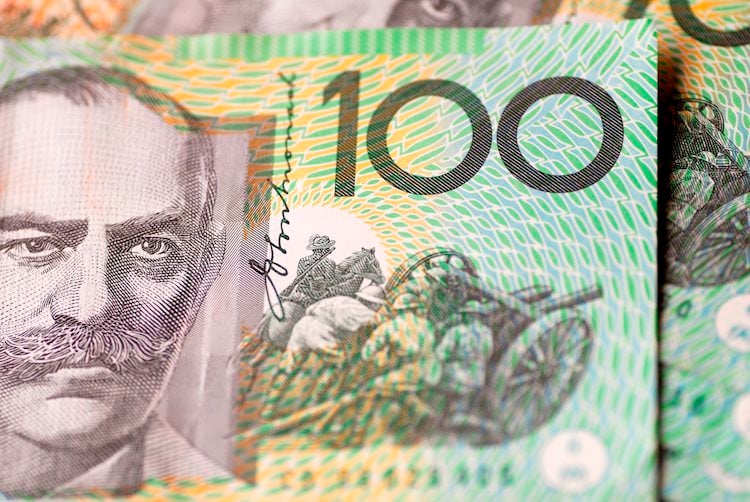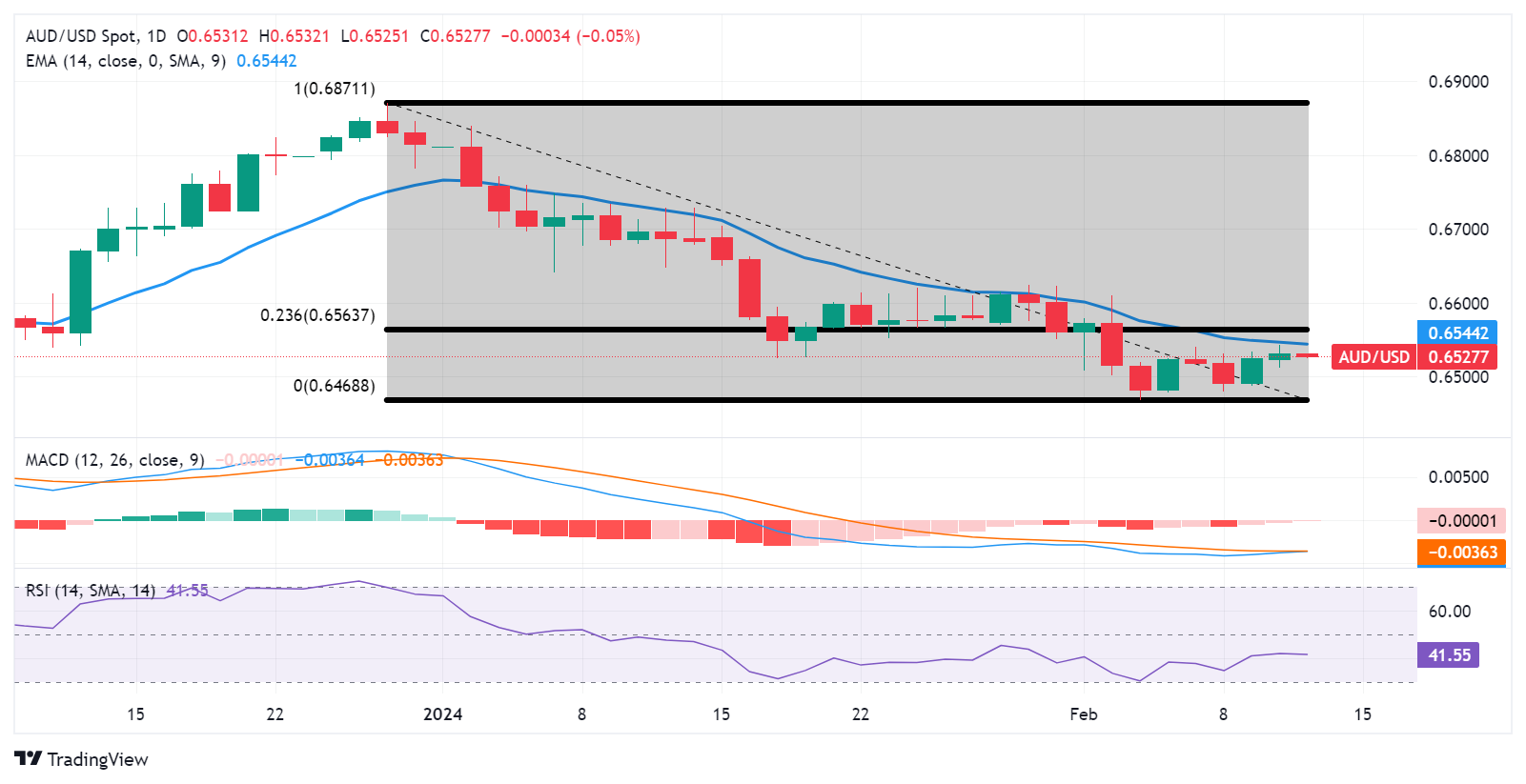- Australian Dollar loses ground amid a stable US Dollar.
- Australian Consumer Confidence jumped 6.2% to 86 in February.
- The US Dollar holds ground despite subdued US Treasury yields.
- US CPI YoY and MoM could moderate to 2.9% and 0.2%, respectively, in January.
The Australian Dollar (AUD) retreats after posting gains in the previous two sessions, despite the release of improved Australia Consumer Confidence data on Tuesday. The Westpac-Melbourne Institute Consumer Sentiment index surged 6.2% to 86 in February from 81 in January, marking its highest reading in 20 months. However, the index remained below the neutral 100 mark since February 2022.
Australian Dollar faces downward pressure as Australian inflation moderates, leading to the market sentiment that the Reserve Bank of Australia (RBA) has completed its monetary tightening cycle. This downward trend in the Aussie Dollar weighs on the AUD/USD pair. Additionally, the Australian money market’s decline may further constrain the AUD’s performance.
The US Dollar Index (DXY) holds steady after recent gains, with the decline in US Treasury yields capping the strength of the US Dollar (USD). Market sentiment is mixed, as traders exercise caution ahead of the release of important US inflation data scheduled for Tuesday, which could influence expectations regarding interest rates.
Daily Digest Market Movers: Australian Dollar declines amid a stable US Dollar
- National Australia Bank’s Business Confidence improved to the reading of 1 in January from the previous flat of 0.
- National Australia Bank’s Business Conditions decreased to 6 in January from 8 prior.
- RBA’s Head of Economic Analysis, Marion Kohler, emphasized uncertainty regarding current inflation projections for the Australian economy. However, she anticipates that price growth will eventually return to a more moderate level by 2025.
- The Commonwealth Bank of Australia (CBA) forecasted a reduction of 75 basis points in the benchmark interest rate for 2024, with the initial cut anticipated in September.
- China’s headline CPI declined by 0.8%, exceeding the anticipated decline of 0.5% and the previous decline of 0.3%.
- Dallas Federal Reserve (Fed) Bank President Lorie K. Logan remarked on Friday that there is currently no pressing need to lower interest rates. She acknowledged “tremendous progress” in curbing inflation but emphasized the necessity for additional evidence to ensure the sustainability of this progress.
- US Monthly Budget Statement came in with the reading of $-22B in January, against the expected reading of $-21B and $-129B prior.
- 3-Month and 6-Month US Bill was auctioned at the rate of 5.23% and 5.065%, respectively.
Technical Analysis: Australian Dollar trades near 0.6530 before the 14-day EMA
The Australian Dollar trades near 0.6520 on Tuesday, situated below the immediate resistance of the 14-day Exponential Moving Average (EMA) at 0.6544 aligned with the major barrier at 0.6550 level. A breakthrough above this major level could potentially prompt the AUD/USD pair to target key levels such as the 23.6% Fibonacci retracement level at 0.6563 and the psychological resistance at 0.6600. On the downside, the psychological level of 0.6500 could act as immediate support. A break below the latter could push the AUD/USD pair to revisit the previous week’s low at 0.6468 followed by the major support level of 0.6450.
AUD/USD: Daily Chart
Australian Dollar price today
The table below shows the percentage change of Australian Dollar (AUD) against listed major currencies today. Australian Dollar was the weakest against the US Dollar.
| USD | EUR | GBP | CAD | AUD | JPY | NZD | CHF | |
| USD | 0.03% | 0.06% | 0.01% | 0.16% | 0.05% | 0.37% | 0.03% | |
| EUR | -0.04% | 0.02% | -0.02% | 0.12% | 0.02% | 0.32% | -0.01% | |
| GBP | -0.06% | -0.03% | -0.05% | 0.10% | -0.02% | 0.31% | -0.01% | |
| CAD | -0.02% | 0.01% | 0.05% | 0.12% | 0.03% | 0.35% | 0.02% | |
| AUD | -0.15% | -0.12% | -0.09% | -0.12% | -0.09% | 0.22% | -0.09% | |
| JPY | -0.06% | -0.01% | 0.00% | -0.05% | 0.09% | 0.30% | -0.03% | |
| NZD | -0.37% | -0.33% | -0.31% | -0.36% | -0.21% | -0.31% | -0.33% | |
| CHF | -0.04% | 0.00% | 0.03% | -0.02% | 0.09% | 0.01% | 0.33% |
The heat map shows percentage changes of major currencies against each other. The base currency is picked from the left column, while the quote currency is picked from the top row. For example, if you pick the Euro from the left column and move along the horizontal line to the Japanese Yen, the percentage change displayed in the box will represent EUR (base)/JPY (quote).
Inflation FAQs
Inflation measures the rise in the price of a representative basket of goods and services. Headline inflation is usually expressed as a percentage change on a month-on-month (MoM) and year-on-year (YoY) basis. Core inflation excludes more volatile elements such as food and fuel which can fluctuate because of geopolitical and seasonal factors. Core inflation is the figure economists focus on and is the level targeted by central banks, which are mandated to keep inflation at a manageable level, usually around 2%.
The Consumer Price Index (CPI) measures the change in prices of a basket of goods and services over a period of time. It is usually expressed as a percentage change on a month-on-month (MoM) and year-on-year (YoY) basis. Core CPI is the figure targeted by central banks as it excludes volatile food and fuel inputs. When Core CPI rises above 2% it usually results in higher interest rates and vice versa when it falls below 2%. Since higher interest rates are positive for a currency, higher inflation usually results in a stronger currency. The opposite is true when inflation falls.
Although it may seem counter-intuitive, high inflation in a country pushes up the value of its currency and vice versa for lower inflation. This is because the central bank will normally raise interest rates to combat the higher inflation, which attract more global capital inflows from investors looking for a lucrative place to park their money.
Formerly, Gold was the asset investors turned to in times of high inflation because it preserved its value, and whilst investors will often still buy Gold for its safe-haven properties in times of extreme market turmoil, this is not the case most of the time. This is because when inflation is high, central banks will put up interest rates to combat it.
Higher interest rates are negative for Gold because they increase the opportunity-cost of holding Gold vis-a-vis an interest-bearing asset or placing the money in a cash deposit account. On the flipside, lower inflation tends to be positive for Gold as it brings interest rates down, making the bright metal a more viable investment alternative.

